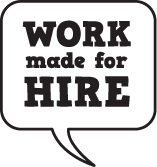Work For Hire or Copyright Assignment?
Here’s a question that keeps popping up in my conversations with creators:
What’s the difference between a “work made for hire” and when I assign my copyright to someone else? In both cases I no longer own the copyright, so what’s the difference?
I’m so glad you asked! Because if you’re a creator who wants to encourage your clients to do the right thing (like pay you), the differences are pretty important.
A work made for hire is when you create something for someone else, the thing fits into one of these nine categories, and you have a written contract that explicitly says the work is a “work made for hire.”
If all of those things are true (or if you’re an employee making something in the “course and scope” of your job), then you never own the copyright to what you create. From the very moment the thing is created, it’s owned by the client or your employer. You can’t use the thing unless your client or employer gives you permission and they can do whatever they want with it even if they fire you in the middle of the project.
When you assign a copyright you are selling it to someone else. And in order to sell the copyright, you have to own it. You own the copyright to something you create so long as it’s not a work made for hire.
Setting aside situations where you make things as an employee, that means: no written contract? It’s not a work made for hire. If the thing doesn’t fit into one of the work for hire categories? It’s not a work made for hire. The contract is written but doesn’t say that what you’re making is a “work made for hire” or “work for hire”? It’s not a work made for hire.
The other rather important thing about a copyright assignment? After 35 years, you can cancel it.
You can go back to the client and say, “Hey, that thing I assigned to you? Yeah. I want it back.” You can do this even if you’ve signed something that says you super duper promise you won’t cancel the assignment; you can’t legally sign this right away.
To recap: when something is a work for hire, you never own the copyright. When you assign a copyright, you own it originally, but you’re giving it to someone else for at least 35 years.
So why should you care?
Well, let’s say you do work for a client and then, for some reason, they don’t pay you.
If what you’ve made is a work made for hire, you can’t stop them from using what you’ve made. If, on the other hand, you’ve promised to assign the copyright once they’ve paid you in full, you can stop them from using what you made. They don’t own it yet, you do. If they want to own it and use it, they need to pay you.
Or, let’s say you want to use what you’ve created in your portfolio. If your creation is a work made for hire, you can’t unless the client gives you permission. If you assign the copyright, though, you can reserve the right to display the work in your portfolio when you give them the copyright. You hold on to that tiny portion (but valuable!) of the copyright and give them everything else.
You might see contracts where they say if the work is not a work made for hire, then you agree that you’re assigning the copyright to the client by signing the contract. If you don’t think what you’re creating fits into one of the work for hire categories and you want the advantage of assigning the copyright under your terms (upon full payment, reserving certain rights, etc.), negotiate to add those requirements to the contract, or work with a lawyer to help make sure that what you’re signing is what you want to sign.
Do you have questions about how copyrights work? Let me know in the comments and I may answer your question in a future post.
Categories: Making Sense of Contracts
Tags: client control, Contracts, copyright, Freelance
« How to Prepare for a Negotiation When You Don’t Have the Time






Great job differentiating the two of these – I never really thought about the difference here, but it makes a lot of sense! One quick question – can I keep the copyright to a ghost written piece of content?
You mention that assigning a copyright allows you to keep the item in your portfolio – and I’m just wondering if that would still work if the article is intended to be ghost written for the client.
Good question! One quick point of clarification though: when you assign your copyright to someone else, they’ll own it entirely. You can include the work in your portfolio if you “reserve” that right when you make the assignment (or if they give you permission in the contract). Reserving rights means you are transferring all of the rights associated with copyright, except ________. So whether you can show the piece in your portfolio will depend on whether you’ve reserved that right, or, if the client wouldn’t agree to an assignment where you’ve reserved rights, if the agreement between you and your client explicitly allows you to include the work in your portfolio.
Hello – Sorry, I just found this article. As a freelance artist, I’m confused: If it is “Work for Hire”, how can a client own and use the work if they have not paid? Everything I have ever read states that ownership transfers upon payment. They are paying for the work – if they do not pay, they do not own. Can you explain?
Hi Chris,
Yours is a good question and a big reason why I wrote the post. If the work is a “work made for hire” payment is not required for the rights to transfer to the client because the client owns the rights from the very beginning. If the client doesn’t pay, they’re in breach (violation) of the contract, and you can try to recoup payment by asking a court to enforce the contract. You can even argue to the court that the client doesn’t own the rights because they haven’t paid for them. I don’t like that approach though, because it requires a lot of work on your end when you didn’t do anything wrong in the first place.
If you want to transfer the rights to the client when they pay, you want a copyright assignment, not a work for hire arrangement. Hope this helps.
If someone starts modeling and the models photos appear on very mainstream items in every store, would they be able to get paid for that if it does well or are they expected to just take the small payment that was initially given to them for the photoshoot. (This was under a work made for hire contract).
I can’t answer a specific question, but I can say that most issues related to who can use what are answered by applying whatever the contract says. In situations where someone’s image is involved, contracts usually have a section (or sometimes a separate document) called a release, that details how the photographer can use that person’s image and for how long.
[…] long as the work you’re creating isn’t a work made for hire, you own the copyright in the work you create as soon as you create it. You can give other people […]
Thanks for this useful article. I have a couple clarifying questions:
— If you are hired as a staff photographer and have no written agreement whatsoever, is it safe to say that the photos you take for that employer are works-for-hire by default and the employer owns the copyright?
— If there’s no written agreement, could you claim copyright ownership after the fact or attempt to grant a license to the employer? If they own the copyright, could they extend a license to you?
Hey Don,
If you have a true employee/employer relationship, then yes, the employer will own the copyright to the work you do for them. The employer isn’t required to say in writing that your work is a work for hire.
Determining if someone is an employee or a contractor is something that there’ve been many lawsuits about. But, generally speaking: if the employer gives the worker access to benefits, and if the employer supplies the worker with all the tools necessary to do the work and controls when and where the work is performed, the worker is an employee.
If the person is *not* and employee, and there is no written agreement, then yes, they could assert copyright ownership and use that to compel the client to pay or to stop using the work in a particular way. Of course, as with many things copyright-related, that’s often easier to say than do, but it is doable.
Cheers!
Katie
Hello, Would you know what is the difference between the two contracts: one as a work-for-hire in which the client retains copyright and one just as a full exclusive buyout. I was asked to create two estimates accordingly but not sure what the difference is, especially in price.